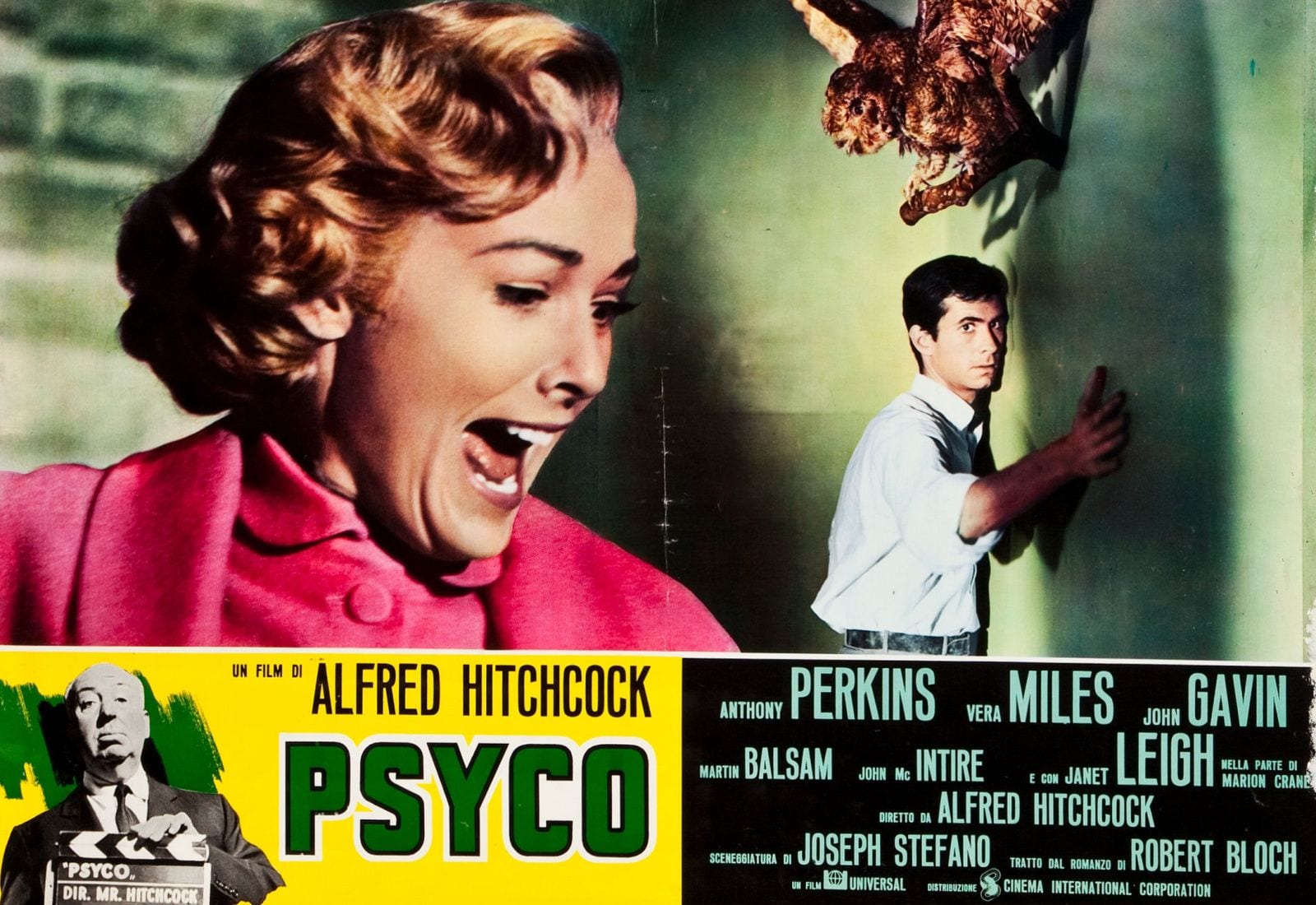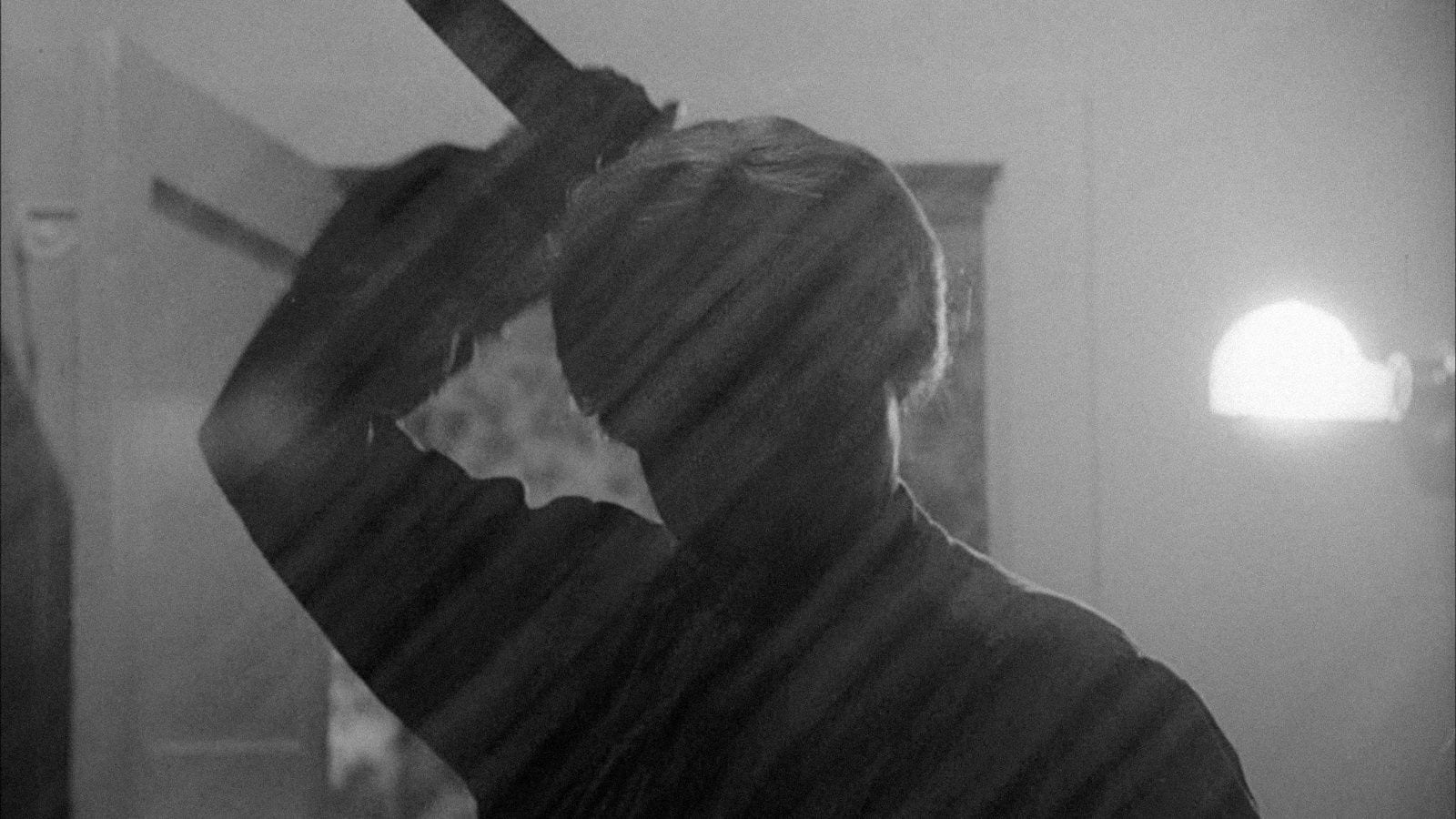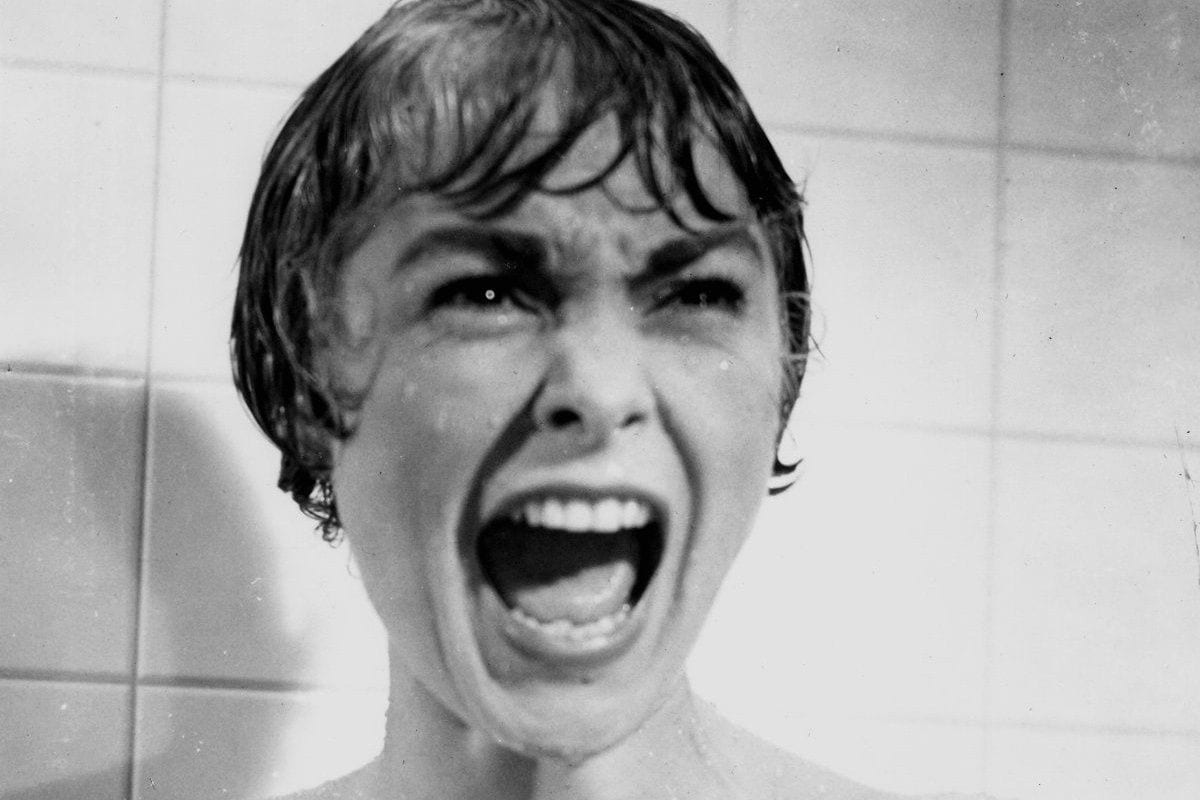
Whether or not you have seen Alfred Hitchcock’s Psycho, released 50 years ago this June, you already know all about the “Shower Scene”. You may have seen the scene itself or parodies of it on TV or in films or online, or heard about it as a perfect example of the power of cinema to thrill and scare. In addition to the eager explanations of movie buffs, you may have experienced its jarring rapid-editing style in “how it was done” exhibitions at the Universal Studios Special Effects Tour. And you have probably heard countless imitations of the screeching violins of its soundtrack with or without the rapid up-and-down bent-arm motions that imitate the knife slashing up the nude body of Marion Crane (Janet Leigh).
As if enacting a new definition of metonymy, of how one thing can stand for another, the “Shower Scene” exemplifies the pleasures and dangers of iconicity: the soundtrack stands for the scene, the scene stands for the film, and the film stands for Hitchcock, for horror movies, and for the power of cinema itself. In Psycho in the Shower Philip J. Skerry indeed describes this as “Cinema’s Most Famous Scene”, and it very well may be. But what one could describe as the scene’s success, its ability to transcend the bounds of its narrative and acquire its own cultural meanings, is also a serious liability. After all, if the scene is enough in itself, what would that imply about film as a narrative art, as the art of images, emotions, and events unfolding in time? And if the “Shower Scene” is a separate text or brand with its own independent cultural meaning, what is the effect of this autonomy for Psycho, and for understanding Hitchcock’s style as a filmmaker? The scene may be proverbial, knowing about it a requirement for contemporary cultural literacy, but is it characteristic of Hitchcock’s work? Or is it perhaps time to get Psycho, and Hitch, out of the shower?
Never one to shy away from the power of branding (the man created a logo out of his own rotund profile), Hitchcock also never challenged the popular fascination with the “Shower Scene”, instead fueling its mystique in his usual ways: narrating his own campy, ironic movie trailers, making choice revelations in interviews about his intentions and designs, and proliferating all the little special tidbits about his directorial command that have slowly risen to the level of folklore. The juicy details combine true and false rumors, from the chocolate syrup used for blood, to the knifed melon that provides the sound of the slashing. Did he turn off the hot water during the filming in order to elicit a more authentic sense of horror from Janet Leigh? Does the knife touch the body? Is anyone, Leigh or her body double, ever naked in the scene?
More importantly, Hitchcock instituted a rule for theater owners, requiring them to follow advertised screening times for starting Psycho, close the doors after the film started, and not allow audiences to come in late or leave and return. As a marketing ploy this was genius, producing a sense of enclosure or claustrophobia for the audience, and activating the darkened cinema as a space with its own mysterious rules — Hitchcock’s rules. Audiences also had to crowd outside the theaters or wait in line for the next screening, and this in turn produced a visible spectacle of the public’s desire to see a film that promised to scare them. Drain by Semevent (Pixabay License / Pixabay)

Drain by Semevent (Pixabay License / Pixabay)
Linda Williams argues that this new discipline — audiences having to arrive on time and stay till the end–creates a structure for then enjoying the film’s unruliness, its uncharted and multidirectional narrative development after Marion’s murder. If Williams’ interpretation locates Psycho within the tenets of postmodern cinema, what I want to offer here is an appreciation of a certain classicism in the film’s narrative structure, which becomes clear when we consider that the closed door policy also forces audiences to experience the film in sequence, in order. From its heist or crime film style in the beginning, to its evolution into a thriller, to the psychiatrist’s explanations of what is going on with Norman Bates (Anthony Perkins) and Mother, to the final moments of Mother’s own voice explaining her motivations yet again, the film depends on numerous retroactive reorganizations of meaning. Oscillating wildly among different sets of generic conventions, Psycho becomes a horror film only at the end, when a skull is superimposed on Norman’s grinning face and the Mother’s voice undermines our sense of the plot once more.
In other words, we are forced to reconstitute what this story is about at every step, constantly revising our expectations as we continue to be bombarded with pieces of information that may be legitimate clues but may also be useless digressions. In a way it is the film’s own complex textual structure that requires experiential orderliness, and it is within this orderliness that the “Shower Scene” has to be experienced, not as the product of a familiar and characteristic Hitchcockean treatment of suspense, of the gradual development of clues, motivations, tensions, and expectations, but as a violation of the rules of narrative development, as the opposite of suspense, as an unmotivated and unexpected surprise.
The distinction between suspense and surprise was one that Hitchcock himself often turned to in order to explain his narrative tendencies as a director. Here is how he describes the contrast in a 1963 interview with Peter Bogdanovich:
“Here we are, back in our old situation: surprise or suspense. And we come to our old analogy of the bomb: you and I sit talking and there’s a bomb in the room. We’re having a very innocuous conversation about nothing. Boring. Doesn’t mean a thing. Suddenly, boom! the bomb goes off and they’re shocked — for 15 seconds. Now you change it. Play the same scene, insert the bomb, show that the bomb is placed there, establish that it’s going to go off at one o’clock — it’s now a quarter of one, ten of one — show a clock on the wall, back to the same scene. Now our conversation becomes very vital, by its sheer nonsense. “Look under the table! You fool!” Now they’re working for ten minutes, instead of being surprised for fifteen seconds.”
The classic treatment of suspenseful narration Hitchcock describes here can be found for example in the tennis match scene of Strangers on a Train (1951): tennis star Guy Haines (Farley Granger) is trying to win the match as quickly as he can, in order to catch a train to the amusement park where Bruno Anthony (Robert Walker), the man who killed his wife, is about to plant a cigarette lighter that incriminates him. The film has worked hard to build up the stakes of this match and its aftermath, with Guy’s friend poised to distract the detectives, the prepaid taxi waiting to take him to the train station, a pair of trousers in the back seat ready for him to wear over his tennis shorts, nighttime fast approaching, and so on. After this masterful orchestration of details, watching the tennis match becomes riveting, as every delay, every move, every lost and gained point fuels a sense of intensity. The silence that often accompanies high-profile tennis matches accentuates the audience’s breathless attention, as everything seems to hinge on the moments of contact between ball and racket, every hit sounding like a gunshot, a heartbeat, or a clock ticking away the precious seconds in the quiet stadium.

Photo: Paramount Pictures
For Hitchcock, such an arrangement often depends on allowing the audience to see or know certain parts of the story, even know the course of the unfolding crime or plan, before the characters, or some of the characters, do. This emotional and narrative preparation of the audience becomes precisely the structure that Hitchcock can then upend, disrupt, challenge, or redirect, rigging the balance between the expected and the unexpected. The suspense structure creates the baseline, in other words, for narrative expectations, and the classic narrative question “what will happen next?” is doubled into “and will things go as planned?” Instead of the pure open-endedness intrinsic in narrative unfolding, the Hitchcock suspense structure creates authoritative expectations that can then be thwarted or undermined. It limits the realm of possible outcomes, and this in effect magnifies small motions and actions.
For example, the counterpart of the tennis match in Strangers on a Train comes in the extreme close-ups of Bruno’s hand reaching for the incriminating lighter, which he has accidentally dropped down a street drain. The action itself may be mundane or predictable, it’s just a man reaching for his lighter, and the scale amazingly small, just a few fingers and an inert object in luminous close-up, but in terms of feeling and intensity the scene is excruciating. Timing, position in the overall narration, differences in scale, crosscutting, silence, and emotional preparation are all important factors in the handling of suspense. Most importantly, no matter how small or unrelated they may seem, set-pieces such as the tennis match or Bruno’s reaching for the lighter have to be related to the through-lines of the film, they have to be experienced as having the potential to make a difference. The implicit contract suspense structures make with their audience is that details will matter.
Considering Psycho in relation to the distinction between suspense and surprise offers some unexpected insights. As many critics have noted, the first part of the film — in which we are introduced to Marion and her boyfriend Sam (John Gavin)–definitely operates according to the rules of suspense, and is indeed a fabulous example of such a setup. In a narrative move that Hitchcock will deploy more than once in this film, we are instructed as audience members to be good detectives, to notice the minute details and the exquisite subtleties of the build-up of Marion’s story: the double entendres and puns, the rich rancher’s smug flirting at the office (“I never carry more than I can afford to lose”) and Marion’s understandable spitefulness at his pithy aphorisms about “buying off unhappiness”.
By the time we see Marion getting dressed, in black bra and slip, with the money and her suitcase on the bed, we have a complete sense of what inspired and what provoked her theft of the $40,000 worked out in our minds. Cause and effect, psychological motivation and character action, action and reaction, these are the epistemological certainties of the heist/detective/crime plot. People do strange things, but they do them for a reason: anger, money, jealousy, spite, self-interest and so on. The emotions and motivations at the core of the story are complex but they are understandable, and the audience is fully in on the action.
In contrast, the “Shower Scene” does not operate according to the structuring of suspense that Hitchcock describes. Instead, it is as if all the suspense the film builds up through the story of Marion, her affair with Sam, the theft of the money, the running away, the anxious drive through the night, is deliberately misplaced, mishandled, thrown away with her sudden murder, following her blood and the camera down the drain of the famous bathtub.

1965 Italian photobusta poster for Psycho (1960) / The Alfred Hitchcock Wiki
How the Shower Scene Violates the Rules of Suspense
The violation of Marion’s body has its counterpart in the parallel violation of the implicit narrative rules of suspense, since nothing at all could have prefigured or predicted this particular event. Even if we become suspicious of Norman during his tense conversation with Marion in the motel’s parlor, we could not have imagined any of the salient details of the case, that this young man has not only taxidermied his mother’s stolen corpse but has also literally absorbed her identity, and killed young women as Mother, dressed in her clothes. These are facts that the film carefully keeps away from us, they are invisible and more importantly un-guess-able, true secrets immune to the most brilliant detection. Narratively speaking, Norman’s story comes from another universe, another planet, as if the rules of the Hitchcock universe have been supplanted by the rules of The Twilight Zone (which had just started airing a year before Psycho). We watch The Twilight Zone with full awareness that anything can happen, any one of the characters can be an alien, psychopath, ghost, android, werewolf, hallucination, and so on.
Far from being suspenseful, the interruption of Marion’s story by Norman’s story is designed to be a shock, a moment of contact with the extreme and the unknowable. Even Bambi Meets Godzilla (Marv Newland, 1969), the cult animated film paragon of weird encounters, offers more prefiguration!
Of course, in the real world things happen that have not been prefigured. Any story could, of course, go in any number of possible directions. But the suspense structure counters precisely these kinds of openness, of both real and narrative worlds, by promising that a certain connection between causes and effects will be respected, and that the audience will have access to at least some of the possible event parameters. Both generic conventions and Hitchcock’s own more characteristic modes of address usually give us such implicit assurances. The only technical presence of suspense in the “Shower Scene” comes in the few seconds between the moment we first see the killer’s outline through the shower curtain and the moment the curtain is pulled back and Marion screams. Even the little bits of information we get about the killer in the scene (the killer’s outline and Norman’s scream “Mother!” after the murder) prove to be misdirection, since the killer is not a woman, and certainly not easily Mother.
To find a scene that indeed operates according to the structures of suspense Hitchcock is famous for, we should instead look at the end of the film: the scene in which Marion’s sister, Lila (Vera Miles), walks up towards the Bates’ House showcases the way that suspense activates and propels the story, inspiring the audience’s sense of engagement with the film and the characters. In contrast to other scary scenes in the film, Lila’s walk towards the house is slow and quiet, takes place in daytime, includes no frightening soundtrack, and does not traffic in the visual vocabulary of fear that the rest of the film involves.
And yet the scene is incredibly suspenseful, and this is a new sense of suspense that the post-“Shower Scene” narrative has worked actively to produce. In contrast to the unexpectedness and suddenness of the shower scene, here we know that the house may be dangerous, that interior spaces are more lethal than exterior spaces in this film, that a murderer lurks somewhere, and that she strikes suddenly. The surprise-based treatment of the two previous murder scenes in the film, Marion’s and Arbogast’s murders, have by this point trained us to consider no place safe, and to expect danger, murder, and sudden screeching violin soundtracks at any point. As a result of this narrative treatment, the more uneventful and quiet Lila’s slow walk through the house remains, the more our sense of suspense is heightened, and tension mounts in the narrative until the final, and surprising, release of the discovery of Mother’s mummified corpse in the cellar.

Film frame from Psycho / The Alfred Hitchcock Wiki
It is also important to note that the suspense structure that leads to Lila’s approach to the Bates’ House is qualitatively different from the suspense structure that begins the film with Marion’s story. With Marion, suspense is at the service of psychological motivation: we know what she is doing and why, but the future is unknowable, even as Marion imagines in her mind what her boss, colleagues, sister, and Sam would say when they find out what she did. The expository style of the first part of the film provides grounding for what is essentially an impulsive action, and presents the desire to control the link between cause and effect, implying that past actions may predict or cause future outcomes. In the implicit temporal line of the film, Marion’s murder comes from the future, as all unexpected events do, and at a moment when she feels she has again taken control of her destiny as she decides to return to Phoenix and restore the money. It is when she thinks she controls the unfolding of the narrative that the narrative unfolds in a completely unexpected dimension. But no level of detail in terms of her past actions could ever have predicted her murder, since there is no direct causal link between the two sets of events.
With Lila’s visit to the Bates house, our sense of suspense is related to expected outcomes and here the past does connect to the actions that follow: we think we know what will happen next, because we have seen what can happen in this film, both in terms of the characters’ previous actions, the Mother’s sudden murder of detective Arbogast (Martin Balsam) for example, and in terms of the film’s developing narrative and visual style. In contrast to Marion’s murder, here we expect the camera suddenly to switch to impossible aerial perspectives, or the killer to jump out of any doorway. This is a more typical treatment of suspense in other words, in which Hitchcock has again created a rubric of expectations that he can tweak or upend. We could not guess the details of the situation between Norman and Mother, but we are right in expecting that the house is dangerous and that both Norman and Mother are not to be trusted.
A narrative map of the film would thus oscillate between suspense and surprise, with each act of the story basically re-training the audience in how things will and will not matter. If we start out as good detectives at the beginning of the film with Marion’s story, our competence is challenged by her murder, as all our clues and storylines are gone. We follow Norman while he cleans up the mess in the bathroom, but we don’t stay with him long enough to figure out what is going on there, instead moving back to the story we are supposedly following: detective Arbogast meets Sam and Lila, and they all try to investigate what happened. Perhaps we get going again in our detective work, and follow the accumulation of clues and insights. Arbogast is killed.
The film brings us back to the now twice broken narrative line of the beginning, taunting us to become invested again in the process of investigation and discovery. But by this point we are much more jaded: when Lila and Sam talk to the town sheriff and his wife, they find out that Norman’s mother has been dead for ten years, and their provocative questions just feel like distractions by now: “Well if the woman up there is Mrs. Bates,” the sheriff asks, “who’s that woman buried in the Green Lawn Cemetery?” Sam and Lila don’t bite and neither do we. In effect, we become worse detectives as the film progresses, we relinquish the kinds of seeing and listening that the suspense structure would depend on, we just give in. None of this matters. The details don’t matter. Just hit me with whatever comes next.
Focusing on the distinction between suspense and surprise in Psycho thus allows us to see how Hitchcock uses both productively, as narrative events that work best in tandem. Psycho purposefully revises the detective story’s classic narrative styles precisely by undermining the workings of suspense. Even though Psycho at first addresses us as a detective/crime/suspense film, its real energy comes from violating the implicit epistemological contract of these generic conventions, and by exploding the tightly woven and perfectly balanced narrative economies of Hitchcock’s earlier films. Psycho enacts and produces a palpable sense of the unknowable, the truly random, which is exactly the opposite of the detective story’s baseline assumptions that both motives and actions can be traceable, that a kind of causality, however strange, rules narrative development, and that the list of motives and implications is limited.
Placing the “Shower Scene” back into Psycho, or getting our understanding of Psycho out of the shower, allows us to appreciate Hitchcock as a narrative director, as a master of the balancing of energies and unfolding of events, rather than as a master of shock. In a contemporary media context, neither the horrific nature of Marion’s murder nor the intensity of the editing and filming style are remarkable—music videos, advertisements, and narrative films all have intensified rates of editing and a much wider available range of what is shocking or unexpected. The real power of Psycho and the quality that remains relevant for contemporary viewers regardless of their slasher violence threshold or horror film training, is the balance between what can be expected and what cannot, what allows an audience to invest deeply in minute details, and what allows an audience to abandon their logic or sense of control and let themselves be thrust about or carried along.
What is masterful about Psycho is not the surprise of the “Shower Scene”, but the way in which Hitchcock manages to gather up that rampant energy again and reorganize it in a newly suspenseful packet afterward. Having constructed a viewer who may sit back and just wait for the next round of fireworks, a viewer for whom suspense is irrelevant, Hitchcock gradually recreates a viewer who cares and looks attentively, a viewer who worries and thinks about what is behind the next door. He scares the wits out of that attentive viewer at the end, of course, but those final terrors are the effect of gradual buildup, a process that culminates in Lila’s approach and slow investigation of the Bates house, in my view the most suspenseful scenes in the film. One can feel the tension mounting as the camera cuts from Lila’s open and determined face to the front door of the Bates house, the doorknob itself glowing with ominous meanings with each cut back and forth. Creating that dense sense of investment for an audience after twice betraying similar feelings earlier in the film is a masterful move indeed.
+ + +
Works Cited
- Linda Williams, “Discipline and Fun: Psycho and Postmodern Cinema” in Reinventing Film Studies. Eds. Christine Gledhill and Linda Williams. New York: Oxford University Press, 2000: 351-378.
- Raymond Durgnat, A Long Hard Look at Psycho. London: BFI, 2002.
- Philip J. Skerry, Psycho in the Shower. London: Continuum, 2009.
- Peter Bogdanovich. The Cinema of Alfred Hitchcock. New York: Museum of Modern Art, 1963.
- Stephen Rebello, Alfred Hitchcock and the Making of Psycho. New York: St Martin’s Griffin, 1998.

